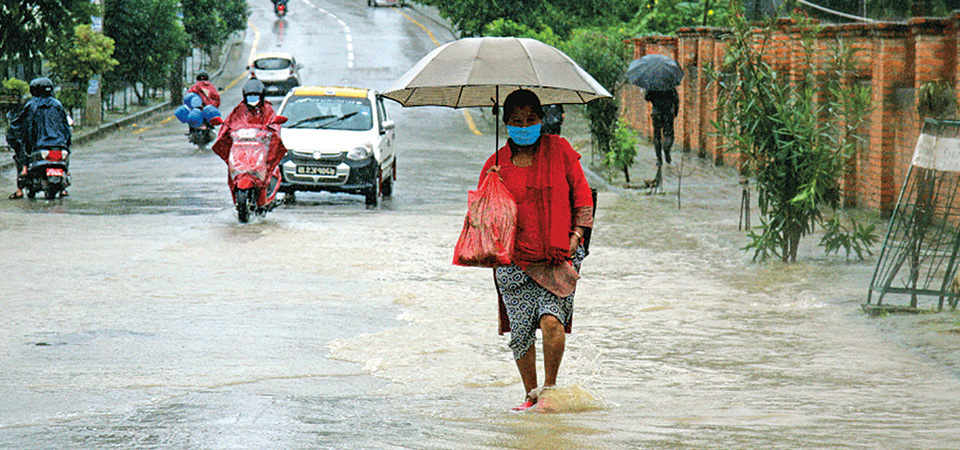Country sees above normal monsoon rainfall

By A Staff Reporter
Kathmandu, Aug. 21: Most of the rainfall gauging stations across the country have already received above normal rains although the monsoon has only reached its halfway.
Monsoon entered Nepal this year on June 11, two days earlier than the normal onset date, and is expected to remain for at least 112 days before retreating, according to senior meteorologist Mean Kumar Aryal.
The onset and withdrawal date of monsoon in Nepal is set for June 13 and October 2 respectively.
As forecast earlier by the South Asian Climate Outlook Forum (SASCOF-19) meeting held on June 10, the Kathmandu Valley including South Asian region (Southwest) are expected to receive normal to above normal rainfall during this monsoon.
Based on the same forecast, most of the stations in different places, including Kathmandu, have already received above normal rainfall as of third week of August.
Some 13 stations out of 20, namely, Dadeldhura, Dipayal, Dhangadi, Surkhet, Jumla, Dang, Bhairahawa, Lumle, Pokhara, Simara, Kathmandu, Jiri, Biratnagar, have already received above normal rainfall as of August 20. Rest of the stations, like Taplejung, Dharan, Dhankuta, Okhaldhunga, Janakpur and Nepalgunj, have received normal to below normal rainfall. Jomsom-based station has yet to provide its monsoon report to the DHM.
If we look at the station of Kathmandu Airport in particular, average monthly rainfall of Kathmandu for August is 330.8 mm and as of August 20, it had received 129.70 mm rainfall.
In July, Kathmandu had recorded 750 to 800 mm rainfall, which should be in between 500 to 550 mm per month. Similarly, according to the monsoon monthly rainfall monitoring report of the DHM, Pokhara’s monthly rainfall, which should remain in between 1000 to 1200 mm for that month, has been found reaching more than 1700 mm.
Likewise, the region around Biratnagar has also received above normal rainfall after July 4. For the month of August, it has already received up to 1100 mm rainfall, which should be in between 800 to 900 for average rainfall.
As the precipitation ratio is increasing across the country, monsoon-induced disaster since July 14 has claimed 83 lives in total in 33 districts so far.
Among the total human casualties, floods alone have claimed 33 lives and landslides 39. Similarly, incessant rains have claimed seven lives, two of whom died in boat capsizal and another two in flooded rivers.
Senior divisional hydrologist at the Department of Hydrology and Meteorology Bikram Shrestha Zoowa said people living in the mountainous and lower belt like Terai region should stay vigilant because monsoon can wreak havoc there anytime.
The mountainous region’s topography has become fragile because of earthquakes and other developmental activities which include haphazard construction of roads and so landslides can strike there anytime, he added.
Recent News

Do not make expressions casting dout on election: EC
14 Apr, 2022
CM Bhatta says may New Year 2079 BS inspire positive thinking
14 Apr, 2022
Three new cases, 44 recoveries in 24 hours
14 Apr, 2022
689 climbers of 84 teams so far acquire permits for climbing various peaks this spring season
14 Apr, 2022
How the rising cost of living crisis is impacting Nepal
14 Apr, 2022
US military confirms an interstellar meteor collided with Earth
14 Apr, 2022
Valneva Covid vaccine approved for use in UK
14 Apr, 2022
Chair Prachanda highlights need of unity among Maoist, Communist forces
14 Apr, 2022
Ranbir Kapoor and Alia Bhatt: Bollywood toasts star couple on wedding
14 Apr, 2022
President Bhandari confers decorations (Photo Feature)
14 Apr, 2022










